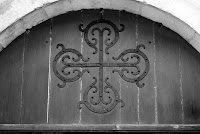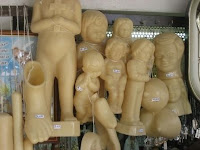

 Imagine for a moment that you are transported back in time to the 13th century. You find yourself in the medieval fortress of Brancion, in southern Burgundy. The ancestral holding of Brancion consists of the castle, a village, and a church.
Imagine for a moment that you are transported back in time to the 13th century. You find yourself in the medieval fortress of Brancion, in southern Burgundy. The ancestral holding of Brancion consists of the castle, a village, and a church.Today you can stand on this high hill and let your mind's eye transport you back to that bygone time. It isn't too difficult, because the landscape before you looks in many ways the same as it did centuries ago: the green farmland, the rolling hills. There is a timelessness here that recalls an illuminated page from a book of hours. The castle, village and church are now a museum, but a museum that lets you use your imagination to flesh out the details of life as it was in the middle ages.
Brancion has not been restored to the extent of other castles and medieval sites in the area. Rather than being a detriment, this actually helps in setting one’s mind free to picture it as it existed in medieval times.
I walked my way through the village in a meditative manner. Many of its structures date to the 15th century. Halfway to the chapel I began to look at a small rock resting on top of a stone fence covered with green moss. I used to think of buildings created centuries ago as set apart and special and that we in America are void of this type of ancient structures. We get excited over structures from the 1800s. I touched the rock and felt its energy. A revelation that all creation is holy came to mind. This rock, as well as the ones that make up the frescoes in the church have the same special energy as the stones in Glen Park Canyon behind St Aidan’s in San Francisco. Wow holiness in my backyard. I now have a new way to look at creation.
I continued to walk and arrived at the church of St. Peter. The church is a perfect example of the Romanesque architecture that is found in many towns and villages in the area. Inside are frescoes that were painted in the XIVth century, when Brancion was a holding of the Dukes of Burgundy. The interior of the church is dark and hushed. A man playing the harp added a greater sense of the Sacred as I meditated on the beautiful frescoes.
One of the frescoes called me to be with it for a while. This was the image that came to mind:
Many pious people are trying to get into a large church. They are dressed as religious and laity with arms raised as they stand before the church whose doors are locked. With their raised hands they wonder why they cannot enter - They have always been the gatekeepers.
A feeling of joy emits from the church which is filled with those who have never been welcomed into it. The ones who have been excluded are now experiencing joy, peace, and liberation. Eventually those who are in the church allow the ones who were locked out to come in and share in this radical experience of hospitality and equality and the old guard is transformed by the love of the former outcasts.
The more one becomes a friend of Christ greater liberation happens.
Every creature, every plant
every rock and grain of sand
proclaims the glory of its Creator
worships through color, shape
scent and form.
A multi-sensory song of praise.
Creator God, may we join
with the whole of your creation
in praising you, our Creator
through the fragrance
and melody of our lives

























